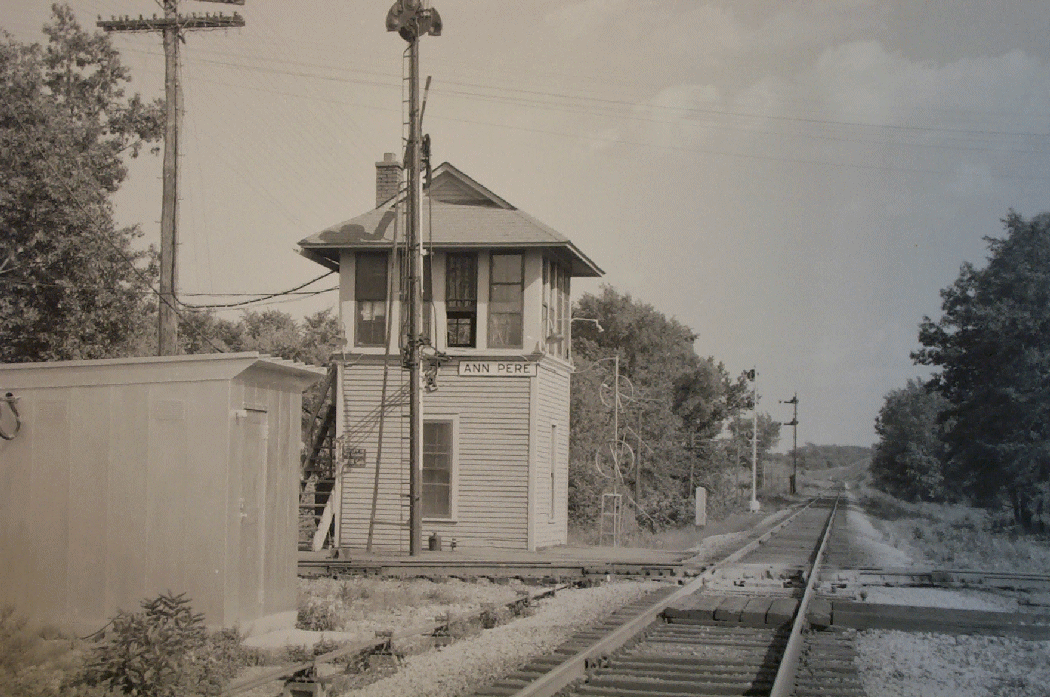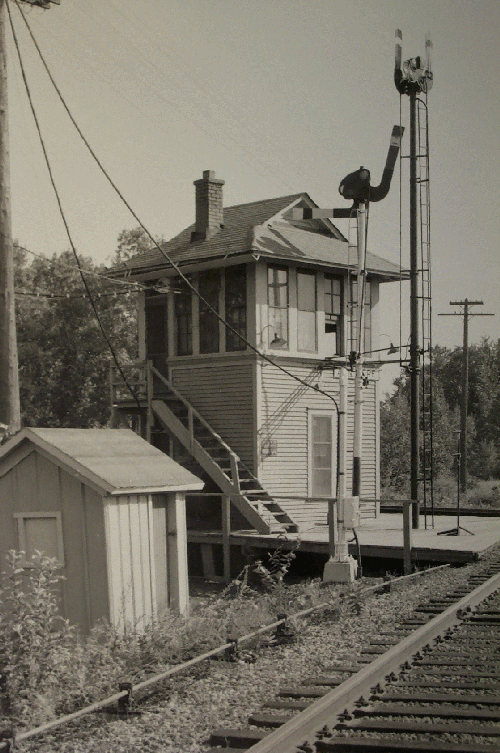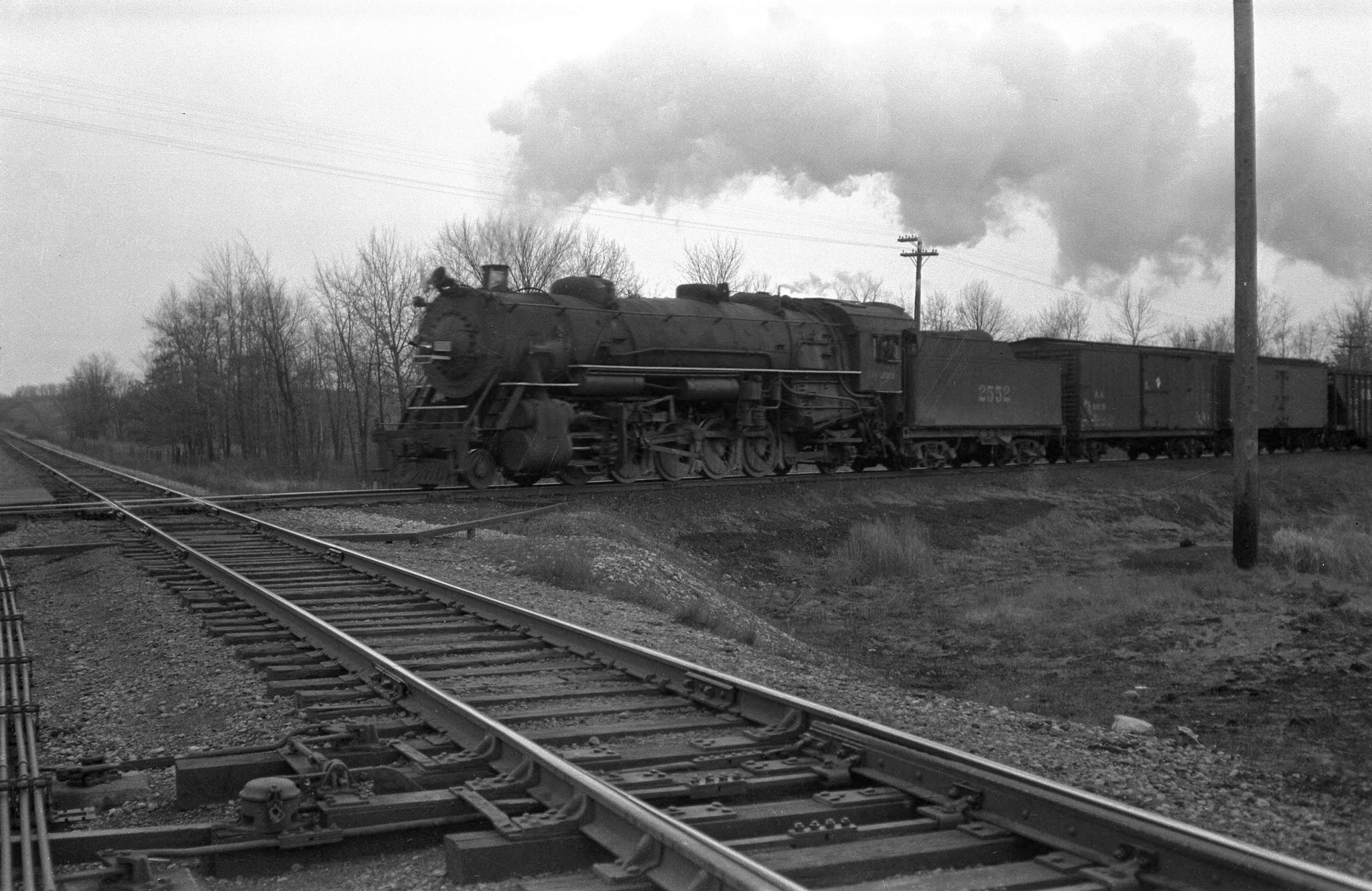- Details
- Hits: 3720
Station: Annpere, MI


 Annpere was created in the farmland east of Howell around 1888, when the Ann Arbor Railroad pushed its way northwest from Toledo to Frankfort. When they reached the Detroit, Lansing & Northern Railroad, Howell Junction was established as the point of this crossing. On October 29, 1895, the Ann Arbor Railroad petitioned the Michigan Railroad Commission to cross the DL&N and the location was designated as Annpere (the first use of this name). The name may not have been publicly adopted until 1906. The name was derived by using the first names of the crossing railroads. In early days, the location had aninterlocking tower and a depot which straddled the main lines of both railroads. It appears that the purpose of the depot was solely to interchange passengers between the two roads, as there was no supporting town at the site. The tower was staffed by PM personnel.
Annpere was created in the farmland east of Howell around 1888, when the Ann Arbor Railroad pushed its way northwest from Toledo to Frankfort. When they reached the Detroit, Lansing & Northern Railroad, Howell Junction was established as the point of this crossing. On October 29, 1895, the Ann Arbor Railroad petitioned the Michigan Railroad Commission to cross the DL&N and the location was designated as Annpere (the first use of this name). The name may not have been publicly adopted until 1906. The name was derived by using the first names of the crossing railroads. In early days, the location had aninterlocking tower and a depot which straddled the main lines of both railroads. It appears that the purpose of the depot was solely to interchange passengers between the two roads, as there was no supporting town at the site. The tower was staffed by PM personnel.
Photo Info: Two views of the Ann Pere tower, date unknown. 3rd photo, Ann Arbor 2552 crosses the PM diamond at Ann Pere in 1937. [UM Bentley Library collection]
Notes
The Michigan Railroad Commission approved the crossing of the DL&N with the following conditions:
- The crossing would be made "at grade" (or level, not with an overpass).
In 1900, this crossing was called Howell Junction on the Ann Arbor railroad. [OG-1900]
- The Ann Arbor Railroad would install, at its own cost, a "first class" interlocking with derails and signals as approved by the Commission the cost of maintaining the interlocking would be divided by the two railroads according to the number of levers use in the tower by each railroad.
- Annpere continues to exist today as an automatic interlocking for the CSX and Tuscola & Saginaw Bay Railroads, as well as the end of a controlled passing siding for the CSX. Both railroads interchange cars at this location on a daily basis. Neither the tower nor station remain.
Time Line
1886. General Manager Mulliken of the DL&N sends a train with 300 employees, a number of whom were armed with clubs to Howell to protect the crossing of their road by the "Ashley Line". Mulliken requested that Governor Alger send troops from the state militia but the request was denied because Alger did not have the authority to do so. A warrant for James M. Ashley Jr. was issued and given to U.S. Marshall Mathews. [DFP-1886-0105]
1886. January. Superintendent J.M. Ashley of the TAA&N railroad, appeared before Commissioner Graves in Detroit and waived examination on the charge of obstructing mail trains during the war with the Detroit, Lansing & Northern at Howell (AnnPere) a few days ago. His trial was set for March before Judge Brown. [WEX-1886-0121]
1888. November. A considerable railroad business is being done at Howell Junction. 15 to 20 trains daily. All trains stop at the Junction depot. An operator, assistant and car repairer are employed during the day and an operator at night. Tickets are sold by the DL&N road and will soon be sold by both roads. Nearly all passenger trains make close connections. The TAA&NM collect no fare from Howell to the junction, nor from the junction to Howell. The distance is about one mile. [LDP-1888-1129]
1896. The mechanical interlocker was installed around 1896 and was a Saxby & Farmer vertical machine with a 12-lever frame (8 working and 4 spare).
1900. This is a telegraph station on the Ann Arbor railroad. [OG-1900]
1907. The tower was destroyed by fire and the interlocker was rebuilt. A new track was added for the Pere Marquette and the Commission approved a 50/50 sharing of the maintenance costs. Passenger trains were limited to 30 m.p.h. when passing through the interlocking. Freight trains were limited to 20 m.p.h.
1908, October. The railroads added electrically locked distant signals to the interlocking at this time, and a wye track had been added along with a siding on the Pere Marquette.
1917. The railroad commission approves for use the interlocking system at Ann Pere. [MCR-1917]
1918. The AARR had a day station agent here as well as a night operator at the tower. Apparently the PM staffed the tower during the day and afternoon shifts. [TRT]
1927. The PM has an operator-leverman assigned her on all shifts. The jobs pay 59-60¢ per hour. [PMTA]
1940, The Michigan Railroad Commission allowed the railroads to remove the derails in an effort to reduce costs. The approach signals (signals located about 1/2 mile back from the interlocking on both roads) were moved further back. This would allow for greater speeds when approaching the crossing.
1945. This was a day and night staffed tower. [ETT-1945]
1951. Track circuitry was added to the passing siding on the Pere Marquette.
1959. The state approved the replacement of the manual mechanical interlocking with an automatic interlocking plant. Automatic interlockings gave a permissive signal to the first approaching train. The tower was closed around this time. The railroads also upgraded the semaphore signals to color light signals, and the C&O dispatcher in Grand Rapids was given supervisory control of the interlocker.
1961. The tower was removed and the crossing was controlled by the new CTC system installed from Plymouth to Lansing. [DH]
Bibliography
The following sources are utilized in this website. [SOURCE-YEAR-MMDD-PG]:
- [AAB| = All Aboard!, by Willis Dunbar, Eerdmans Publishing, Grand Rapids ©1969.
- [AAN] = Alpena Argus newspaper.
- [AARQJ] = American Association of Railroads Quiz Jr. pamphlet. © 1956
- [AATHA] = Ann Arbor Railroad Technical and Historical Association newsletter "The Double A"
- [AB] = Information provided at Michigan History Conference from Andrew Bailey, Port Huron, MI

